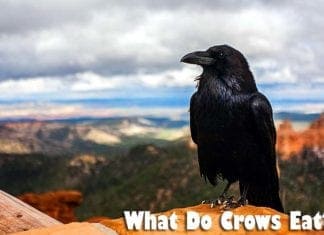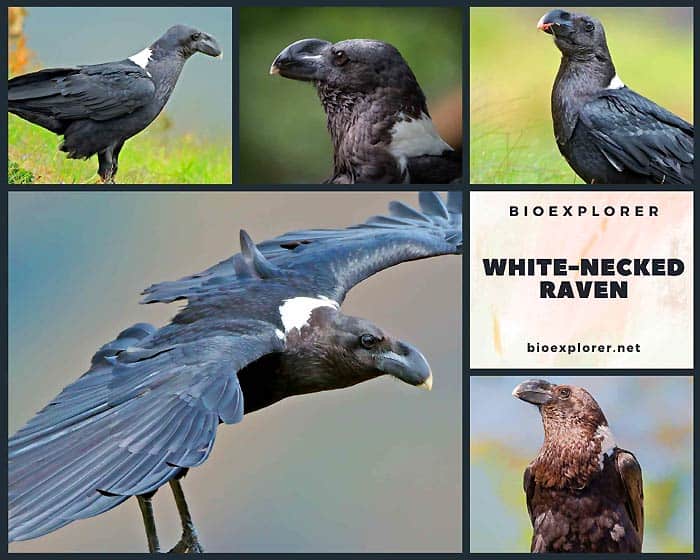
| Animalia | Passeriformes | Corvidae | Corvus | Corvus albicollis |
The white-necked raven (Corvus albicollis) is a striking and intelligent member of the corvid family, native to Africa’s highland regions. This species stands out for its distinctive appearance, remarkable adaptability, and complex behaviors among the many types of birds found across the continent.
Found primarily in eastern and southern Africa, the white-necked raven thrives in various habitats, from rugged mountains to open savannas, often at high elevations. Its adaptability is further demonstrated by its presence in both wild and urban environments, where it can be seen foraging for food and interacting with other wildlife.
Table of Contents
- Common Name: White-necked raven.
- Family: Corvidae
- Body Dimensions: 50 to 54 cm length, 752 to 860 mm wingspan.
- Male Plumage Colors: Glossy black, white nape, purple gloss.
- Female Plumage Colors: Glossy black, white nape, purple gloss.
- Habitat: Open, mountainous regions, cliffs.
- Diet: Omnivorous; carrion, fruit, various insects, grains.
- Native Countries: Kenya, South Africa, Lesotho, Ethiopia, and more.
- Continents: Africa
White-necked Raven Characteristics
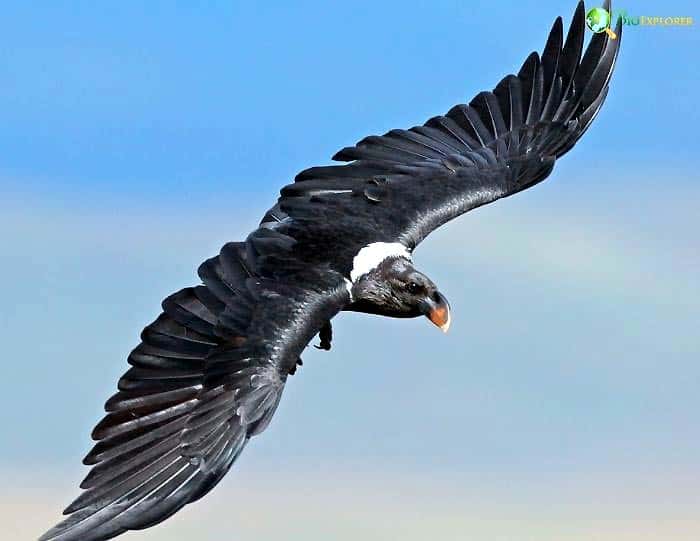
The white-necked raven is a large, robust bird, typically measuring between 50 and 54 centimeters, with a wingspan reaching up to 1.2 meters.
- Its most distinguishing feature is the prominent patch of white feathers on the nape of its neck, which contrasts sharply with the otherwise glossy black plumage covering the rest of its body. The feathers themselves possess a purplish sheen in certain lighting conditions.
- Another notable characteristic is the raven’s thick, heavy bill, which is deeply arched and has a noticeable notch near the tip. This powerful bill is well-adapted for a varied diet, allowing the bird to break into tough food items such as seeds, nuts, and bone fragments.
- Sexual dimorphism is minimal, with males and females appearing similar in size and coloration, making it difficult to distinguish between the sexes in the field. The eyes are dark brown, and the facial expression is often described as intelligent and inquisitive.
- Juvenile white-necked ravens resemble adults but tend to have duller plumage and lack the fully developed white neck patch until they mature.
- The species is easily recognized in flight by its broad wings and short, wedge-shaped tail, differentiating it from other large black birds.
Overall, the white-necked raven’s combination of size, coloration, and bill structure makes it one of the more distinctive and easily identifiable birds of Africa.
White-necked Raven Habitat
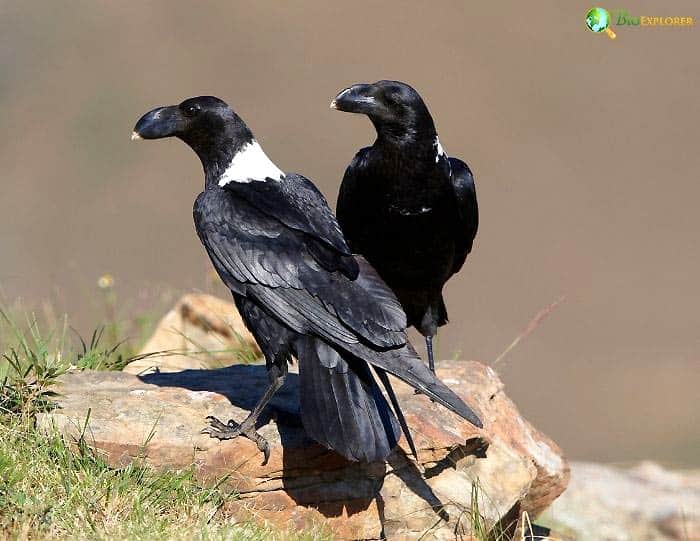
The white-necked raven is predominantly found in the highland regions of eastern and southern Africa, inhabiting countries such as Ethiopia, Kenya, Tanzania, South Africa, and Lesotho.
- It favors mountainous and hilly terrain, often at elevations ranging from 1,200 to 4,500 meters. However, it can occasionally be found at lower altitudes.
- The species is highly adaptable and occupies a variety of habitats, including rocky outcrops, cliffs, open grasslands, savannas, and even agricultural areas.
- While it prefers remote and rugged landscapes, the white-necked raven is also known to venture into urban environments, especially where abundant food sources are.
- It is commonly observed near human settlements, scavenging at rubbish dumps, and exploiting food waste.
- Nesting sites are typically located on cliff ledges tall trees, providing safety from ground-based predators.
Diet and Hunting Behavior
The white-necked raven is an omnivorous and opportunistic feeder, displaying remarkable adaptability in its diet and foraging strategies.
- Its diet encompasses various food items, including insects, small vertebrates, carrion, seeds, fruits, and human food scraps. The powerful, arched bill allows the raven to tackle tough food sources, such as cracking open seeds and nuts or tearing into carcasses.
- The species often scavenges at rubbish dumps, roadkill, and abattoirs, taking advantage of human-generated waste.
- In more natural settings, it hunts insects and small animals, sometimes flipping over stones or probing into crevices to extract hidden prey.
- The white-necked raven is also known to follow large mammals or birds of prey, capitalizing on leftovers from their kills.
- One of the most intriguing aspects of its feeding behavior is its use of intelligence and problem-solving skills. The raven has been observed dropping hard-shelled food items from heights onto rocks to break them open, a clear example of tool use in birds. It may also cache surplus food in hidden locations for later consumption, demonstrating foresight and memory.
- Social foraging is common, with pairs or small groups working together to exploit food sources.
- Aggressive interactions may occur at abundant food sites. Still, the species generally displays a high degree of tolerance and cooperation within its social groups.
This flexibility in diet and foraging behavior has enabled the white-necked raven to thrive across various environments.
Suggested Reading:
What Do Crows Eat?
Breeding Behavior
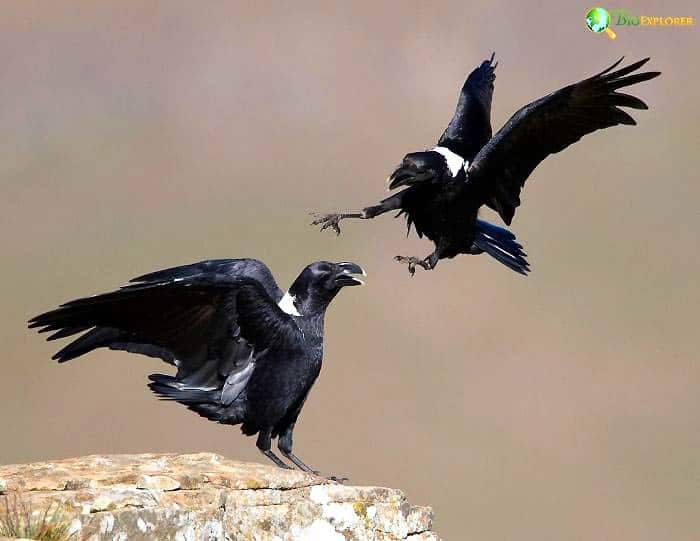
The breeding behavior of the white-necked raven is characterized by strong pair bonds and elaborate nest construction. Pairs are typically monogamousWhat is monogamous?In biology, monogamous refers to a mating system in which an individual has an exclusive reproductive partnership with a single mate during a breeding season or for life., maintaining long-term partnerships that may persist for several breeding seasons. Courtship displays involve mutual preening, aerial acrobatics, and the exchange of food items, which help strengthen the bond between mates.
- Nesting usually occurs on cliff ledges or in tall trees, with the site chosen for its inaccessibility to predators.
- The nest is a large, bulky structure composed of sticks, twigs, and other plant materials, often lined with softer substances such as grass, wool, or animal hair.
- Both pair members participate in nest building, although the female typically assumes a greater role in shaping and lining the interior.
Egg-laying generally occurs during the dry season, with clutch sizes ranging from 3 to 6 eggs. The eggs are pale green or blue with brownish markings, providing camouflage against the nest lining. Incubation is primarily performed by the female and lasts about 18 to 20 days, during which the male provides food and guards the nest site.
- Upon hatching, the chicks are altricialWhat is altricial?Altricial animals are born in an underdeveloped state, unable to see, move well, or feed themselves. For example, many songbirds hatch blind and featherless, relying entirely on their parents for warmth and food. and require constant care and feeding from both parents. The nestling lasts approximately 35 to 45 days, during which the young are fed a diet of insects, small animals, and regurgitated food.
- Parental investment remains high even after fledging, with juveniles often staying with their parents for several weeks as they learn to forage and navigate their environment.
Breeding success is influenced by food availability, nest site security, and weather conditions. Predation by larger birds of prey and nest disturbances by humans or livestock can threaten eggs and chicks.
Interactions with Other Wildlife
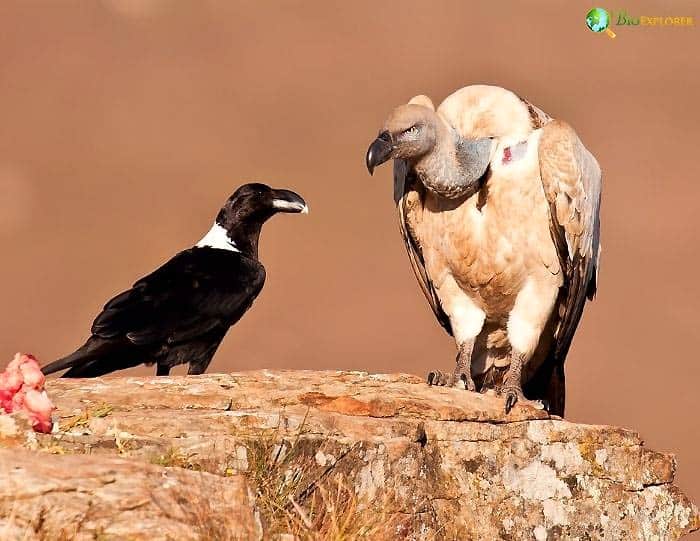
The white-necked raven interacts with various other wildlife species in its environment, both as a competitor and as a participant in multiple ecological relationships.
- It is often associated with other scavenging birds, such as vultures and corvids, especially at carcass sites or rubbish dumps. These interactions can be competitive, with ravens sometimes engaging in aggressive displays or vocalizations to assert dominance over food resources.
- The species is also known to follow large mammals, such as ungulatesWhat is ungulates?Ungulates are hoofed mammals that typically use the tips of their toes, usually encased in keratinous hooves, to support their weight while moving. This diverse group includes animals like deer, horses, pigs, and giraffes, and is divided into odd-toed (perissodactyls) and even-toed (artiodactyls) ungulates., to take advantage of insects flushed from the grass or to feed on leftovers from predator kills.
- While it occasionally preys on the eggs or young of other bird species, it is also subject to predation by larger raptors.
- The white-necked raven may sometimes alert other animals to danger through loud calls.
Suggested Reading:
Top 15 Wildlife Biology Degree Programs In The USA
Ecological Importance of White-necked Ravens
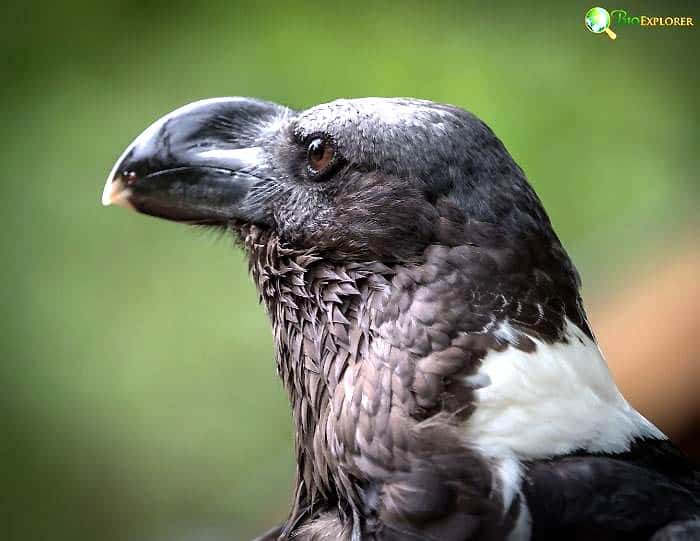
The white-necked raven is currently classified as a species of Least Concern by the International Union for Conservation of Nature (IUCN).
- Its wide distribution across eastern and southern Africa and adaptability to various habitats have contributed to stable population numbers.
- No major widespread threats have been identified for this species. However, localized pressures such as habitat destruction, human disturbance, and persecution in some areas may have minor impacts.
The ecological importance of the white-necked raven lies in its role as both a scavenger and a predator.
- By consuming carrion and waste, the species helps to maintain ecosystem cleanliness and reduce the spread of disease.
- Its predation on insects and small animals can also help regulate populations of potential pests.
Conservation efforts for the white-necked raven primarily focus on monitoring population trends and protecting key habitats, particularly nesting and foraging sites.
White-necked Raven Fun Facts
- The white-necked raven’s vocalizations vary, including mimicked sounds, unusual clicks, and whistles, not just the typical raven croak.
- These ravens often perform playful aerial stunts in flight, such as rolling and somersaulting, especially during windy conditions.
- They have been observed sliding down snowbanks or smooth surfaces for apparent amusement, a rare behavior among birds.
- White-necked ravens sometimes collect and cache shiny objects, such as pieces of metal or glass, in addition to food.
- The species is known to engage in “anting“, allowing ants to crawl over its feathers, possibly to help control parasites.
- Unlike many birds, white-necked ravens have been observed using their feet to hold food while eating, demonstrating advanced dexterity.
- These ravens occasionally join mixed-species flocks during non-breeding seasons, which may help them locate food more efficiently.
- The white-necked raven’s scientific name, albicollis, is derived from Latin and means “white-necked”, directly referencing its most distinctive physical trait.
Frequently Asked Questions
How long do white-necked ravens live in the wild?
While precise lifespan data is limited, corvids in general are known for their longevity. White-necked ravens are believed to live several years in the wild, with some potentially reaching over a decade if conditions are favorable.
Are white-necked ravens migratory?
No, white-necked ravens are primarily resident birds. They do not undertake long-distance migrations, although they may move locally in response to food availability or environmental changes.
What are the main vocalizations of the white-necked raven?
Their calls are deep, guttural, and varied, including croaks, caws, and even some mimicked sounds. These vocalizations affect communication, territory defense, and social interactions.
Are white-necked ravens easy to spot in the wild?
They are relatively conspicuous due to their size, loud calls, and tendency to perch in open, elevated locations. Their white neck patch makes them easily distinguishable from other large black birds.
What is the role of white-necked ravens in local cultures?
In some African cultures, the white-necked raven is featured in folklore and is sometimes regarded as a symbol of intelligence or mystery.
Do white-necked ravens interact with humans?
Yes, they are often seen in human-altered environments, scavenging in towns and cities, and sometimes become accustomed to people, especially near food sources.
Occupying a wide range of habitats across eastern and southern Africa, the white-necked raven plays a vital role in its ecosystem as both a scavenger and a predator. Its social behaviors, problem-solving abilities, and capacity to thrive in wild and urban environments underscore its ecological success. Despite some localized threats, the species remains widespread and abundant, reflecting its ability to navigate the challenges of a changing landscape.
The white-necked raven is a remarkable and resilient bird, distinguished by its striking appearance, intelligence, and adaptability.
![]()


